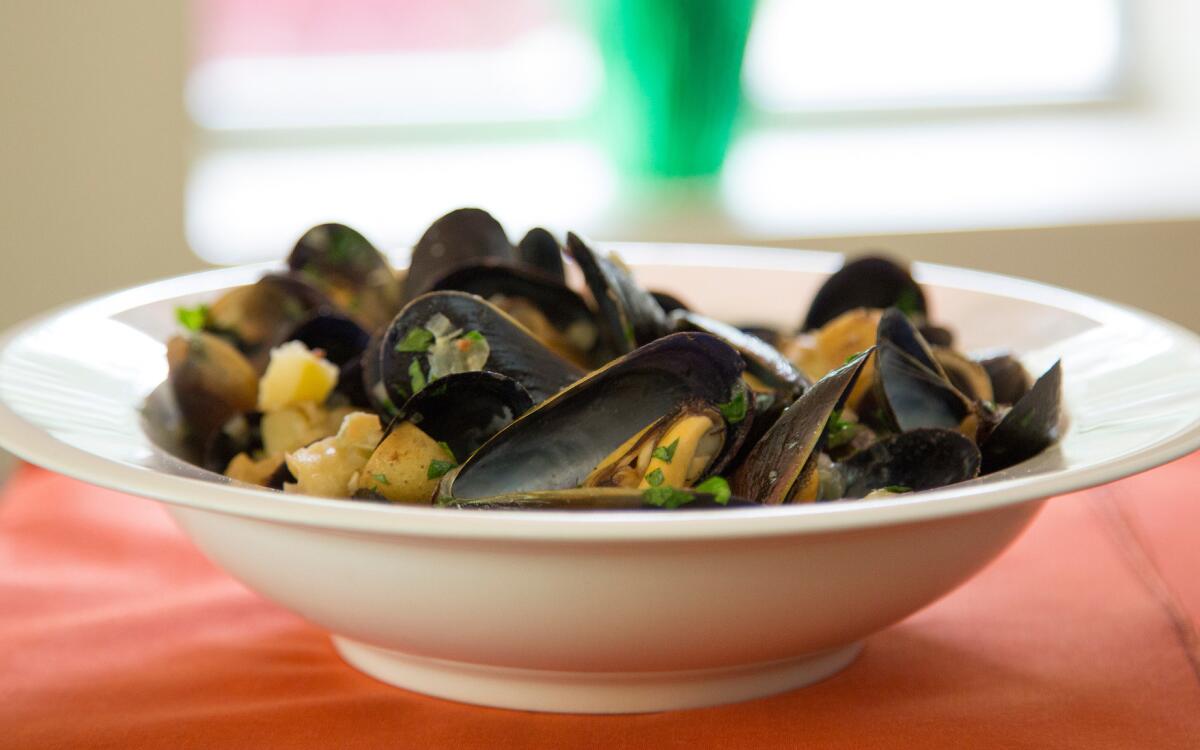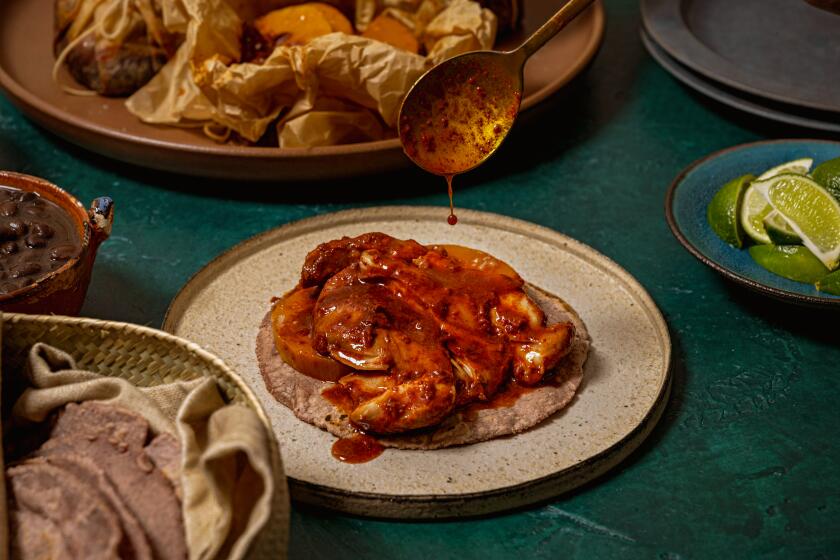Mussel stew with potatoes and sausage

- Share via
Seafood soups and stews fall into two categories: rustic, easy, comforting dishes with big flavors and a balance of seafood and vegetables,; and richer, more refined and more labor-intensive affairs like seafood bisques, or French soupe de poissons, and its Southern French counterpart, bouillabaisse. The latter are special occasion dishes best left to restaurants with a budget for labor and specialty fish. It’s the rustic, country-style soups and stews that are fun to make at home, both for dinner parties and family meals.
These hearty soups don’t require elaborate fish stocks — which can be a good thing, as it’s not always easy to find the fish heads and bones that a good fish stock requires. The procedure for two of these recipes, the Provençal fish chowder and the Veracruzana crab soup, is identical. You begin by making a robust tomato sauce base, then add water or a light vegetable stock, the additional vegetables and aromatics called for in the recipe, bring the mixture to a boil, and simmer until the vegetables are tender. Shortly before serving, add the fish or crabmeat.
For a bit more of the sea, there are anchovies in the tomato base that’s at the foundation of the Provençal fish chowder. It’s embellished with the broth from the steamed mussels that accompany each serving. As for semantics, I like to call this soup a chowder because, like a Manhattan clam chowder, it has a tomato base and an abundance of potatoes. But its hallmark Southern French flavors — lots of garlic, a good pinch of saffron, the perfume of orange zest and fennel — leave no doubt that the fragrant dish is decidedly Provençal.
As for the type of fish to use in this soup, you have lots of flexibility. The fish should be white-fleshed (not salmon), but your budget and the quality of what’s available can help you decide. I often use what fish stores call “chowder mix,” a low-cost mix of pieces of different fish; but tell the fishmonger not to include any salmon or tuna in the mix, because their flavors are too strong. (I’ve even used the frozen Alaskan cod from Trader Joe’s with very good results. Just make sure to remove it from the package and thaw in a bowl in the refrigerator overnight, then to drain off any water from the bowl.)
The distinctive flavors of the Veracruzana soup come from the minced olives, capers and pickled jalapeños that are cooked along with onions, garlic and tomatoes in the soup base. It may seem curious to find olives, capers, and olive oil in a Mexican dish, but the cuisine of the of Veracruz has strong ties to the Mediterranean. Veracruz was for centuries the gateway to Mexico, and Spanish foodways are reflected in the widespread use of ingredients such as olive oil, olives, and capers. I prefer to make the soup with crab only, but, the price of crabmeat being what it is, you can also combine crabmeat with white-fleshed fish like cod or snapper.
Both of these stews are perfect for big dinner parties. You can make them, up until the point of adding the fish or crabmeat, hours or even a day or two in advance, which is always something I look for in a recipe when I’m planning a dinner.
The mussel stew with potatoes and sausage is better for smaller dinners, for four4 people, say, mainly because of the amount of space mussels require in a pan. The stew is inspired by a number of Portuguese and Catalonian seafood dishes that bring earth and sea together, usually in the form of sausage and seafood such as mussels or clams. The potatoes contribute substance and comfort, their flavor irresistible because of the way they absorb the flavorful broth.
The base for this stew — the sausage, potatoes, and onions — can also be prepared a few hours ahead. It’s hard to go wrong as long as you don’t boil the fish, or steam the mussels for too long. Just keep the soup at a low simmer, until the fish is cooked through, check seasonings, steam mussels only until they open up, and you’re good to go.
All of these dishes make wonderful one-dish meals — maybe follow with a crisp green salad. And if you want to get more seafood into your diet but you’re not a confident fish cook, this is a great place to begin.
Martha Rose Shulman is a cookbook author and food writer based in Los Angeles.
Clean the mussels: Inspect each mussel, discarding any that have opened (if some are partially opened, tap them with your finger and if they close back up they are OK) or have cracked shells. Wash the mussels, swishing them in a bowlful of water and scrubbing if necessary before thoroughly rinsing. Remove the beards no more than an hour before cooking. Set aside.
In a heavy, straight-sided, lidded frying pan or casserole, heat 1 tablespoon olive oil over medium heat and add the sausage. Cook, stirring until it begins to brown and release fat, then stir in the potatoes. Reduce the heat slightly, cover and cook until the potatoes are lightly browned and tender, stirring often, 10 to 15 minutes. Season with ½ teaspoon salt and several grinds of pepper, or to taste. Remove from heat and transfer the mixture to a bowl. Set aside.
Heat the remaining olive oil in the pan over medium heat. Add the onion and cook, stirring and scraping the bottom of the pan, until the onion begins to soften, about 3 minutes. Add a generous pinch of salt, cover, and reduce the heat to low. Continue to cook, stirring often, until the onion is tender and lightly colored, about 15 minutes. Add the garlic and thyme and cook, stirring, for another minute.
Stir the sausage and potatoes back into the pan with the onions. (At this point you can set the pan aside off the heat, until ready to serve. Reheat before continuing.) Add the wine and increase the heat to high, bringing the wine to a boil. Reduce the heat slightly and boil the liquid for two minutes. Add the mussels and cover the pan tightly. Cook 2 minutes, shake the pot vigorously and cook another 2 minutes. Transfer the opened mussels to soup bowls (if any haven’t opened, give them another minute or so to cook, then discard any unopened ones).
Taste the broth and adjust the seasoning if desired. Stir in the parsley (or parsley and cilantro). Using a slotted spoon, distribute the sausage, potatoes and onions equally among the bowls, then spoon over the broth and serve.
Get our Cooking newsletter
Get a taste of Los Angeles — and the world — with recipes and kitchen tricks from the L.A. Times’ Cooking newsletter.
You may occasionally receive promotional content from the Los Angeles Times.















